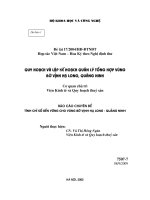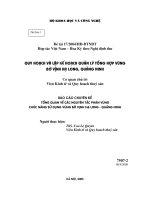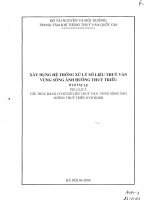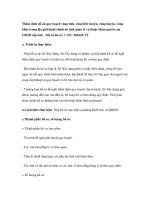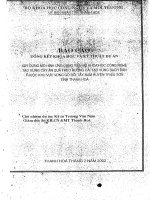Learner autonomy and task based learning of vocabulary học sinh tự học từ vựng theo phương pháp học dựa trên bài tập
Bạn đang xem bản rút gọn của tài liệu. Xem và tải ngay bản đầy đủ của tài liệu tại đây (24.68 MB, 57 trang )
ACKNOWLEDGEMENTS
First, I would like to express my gratitude to all the members of my
family: my beloved mother and sister for having given me love, great support,
motivation and encouragement for me to accomplish my university education.
Next, I would like to send my profound appreciation to my highly
respected advisor, Ms Le Thu Thuy, who has given me much support, useful
instructions, and careful correction of my graduation paper.
I would like to extend my heart-felt gratitude and respect to all the staff in
charge of the Department of Foreign Languages and the teachers in this
Department, who have provided me with necessary knowledge and experience
during my four years at this university. The invaluable knowledge and
experience I have gained through my university years have enabled me to fulfill
this graduation paper.
Last but not least, I would like to send my profound appreciation to all my
friends in class SAIOOlfor having given me precious and supportive advice and
encouragement for me to accomplish this paper. I also express my sincere thanks
to all the students who have helped me to collect data from the questionnaire.
Again, I would like to express my profound gratitude to all.
1
ABSTRACT
Nowadays, students have many means to learn foreign languages. They
can learn from teachers, books, language softwares, or from the Internet.
Language learners always need to acquire a large amount of vocabulary to be
able to read and listen to texts of different areas of interest in order to widen their
knowledge. In addition, students who possess a large stock of vocabulary can be
successful in oral communication
in many situations. However, although
teachers in the Department of Foreign Languages of Ho Chi Minh City
University of Foreign Languages and Information Technology (HUFLIT) have
always
encouraged
students
to
form
a habit
of learning
vocabulary
autonomously, about half of the respondents in an investigation revealed that
they still have problems acquiring and retaining new words.
Teacher autonomy and learner autonomy in connection with task-based
learning and leamer-centered
teaching has been widely discussed among
language teachers. In fact, autonomous learning has been encouraged in many
universities teaching foreign languages including HUFLIT. Nevertheless, most
students who are attending the university find it difficult to leave behind their old
habit of passive learning, and they rely too much on their teachers' explanation
when learning the language.
The objective of this study was to investigate into the effectiveness of
task-based learning in helping students acquire new vocabulary. Our emphasis
was on making use of learner autonomy to enable students to learn vocabulary
through tasks.
The researcher designed a questionnaire with seven questions, which was
distributed to10l participants, most of whom were seniors majoring in English at
2
the Department of Foreign Languages of HUFLIT. The questions were mainly
about the participants' method(s) of learning vocabulary during their attendance
at the university.
The data from the survey showed that fewer than half of the participants
had obtained the routine of learning vocabulary through the contexts of the
reading passages, and these participants agreed that learning vocabulary in this
way had enabled them to understand the meanings of the new words thoroughly,
and later they could make use the words they had learned effectively. On the
basis of the data collected, the researcher tried to gather more information about
how to design relevant activities through which successful task-based learning
can be carried on.
With the limited amount of time available and little expenence, the
researcher could not carry out the study in depth. Besides, we could gain
responses from onlylOl participants; therefore, the results cannot be considered
as very reliable. The researcher only hopes that this paper may bring to language
teachers and learners some thoughts about how to make use of task-based
learning to help students learn vocabulary successfully. We suggest that further
research should be carried on with a larger number of participants and with more
varieties of task-based learning.
3
.
TOM LUaC
Ngay nay, sinh vien co nit nhi~u phuong ti~n d~ hQc ngolili ngfr. HQ co th~
hQc ill gilio vien, sach va, cac phfin m~m dlilYngon ngfr ho~c ill mlilng Internet.
Nhfrng nguai hQc ngon ngfr Iuon cdn phai co mQt IUQ11g16n ill VlJIlg d~ co th~
dQCva nghe cac bai kh6a v~ cac lInh V¥Ckhac nhau d~ rna rQng ki~n thuc. Them
vao do, sinh vien sa hfru mQt IUQ11g16n v6n ill VlJIlg se co th~ giao ti~p co hi~u
qua trong nhi~u tinh hu6ng. Tuy nhien, m~c du cac giao vien
a Khoa
Ngolili ngfr
Clla truang Dlili hQc Ngolili ngfr- Tin hQc Thanh ph6 H6 Chi Minh (HUFLIT) iuon
dQng vien sinh vi en hinh thanh th6i quen tIJ hQc ill VlJIlg, khoang mQt mla sinh
vien duQ'c khao sat cho th~y r~ng hQ v~n g~p kho khan trong vi~c hQCva nha ill
maL
Vi~c dlilYva hQCngolili ngfr mQt cach tIJ cM k~t hQ'P vai vi~c hQc d\1'atren
bai t~p va phuong phap I~y nguai hQc lam trQng tam dfi duQ'c thao Iu~n rQng rai
trong cac giao vien dlilYngon ngfr. Th\1'c t~ Ia vi~c hQc t\1'cM dfi duQ'c khuy~n
khich
a nhi~u
truang dlili hQc dlilYngolili ngfr trong do co truang HUFLIT. Tuy
nhien, da s6 sinh vien dlilihQc d~u th~y kho khan khi phai b6 th6i quen hQc th\!
dQng va ph\! thuQC qua nhi~u vao bai giang clla giang vien khi hQ hQc ng6n ngfr.
M\!c dich clla bai nghien cuu nay Ia d~ tim hi~u tinh hi~u qua clla vi~c hQc
d\1'a tren cac bai t~p trong vi~c giup sinh vien hQc ill maL TrQng tam cua bai
nghien CUu nay Ia tim hi~u tinh hi~u qua Clla vi~c dlilYva hQc tu VlJIlg thOng qua
ngfr canh. Nguai nghien CUu dfi thi~t k~ mQt bai khao sat g6m bay cau hOi va
phan ph6i cho 101 sinh vi en nam thu tu chuyen nganh ti~ng Anh cua Khoa
Ngolili ngfr, truang HUFLIT. Cac cau hOi cM y~u Ia v~ phuong phap va kTthu~t
hQc ill v\fllg cua sinh vien trong khi hQc tlili truang Dlili hQc Ngolili ngfr- Tin hQc
Thanh ph6 H6 Chi Minh .
4
Cac dfr li~u ill beii khao sat tren cho thfty la khong dAy mQt lllIa s6 nguai
duQ'c khao sat noi la hQ dii dung ngfr canh cua bai dQc d~ hQc tit vvng, va cac
sinh vien nay d@ud6ng
y la vi~c
hQc ill vvng theo cach nay giup hQ co th~ hi~u
nghla ella ill vvng mQt cach ro rang va sau do hQ co th~ sir d\lng nhfrng ill nay co
hi~u qua. Tit kSt qua cua bai khao sat, chUng toi biSt duQ'c r~ng vi~c hQc ill vvng
thong qua bai t?P mang dSn nhfrng kSt qua t61. Do do, chung Wi c6 g~ng thu th?p
them nhi@u thOng tin han v@cach thiSt kS cac hOl;ltdQng thich hgp d~ vi~c hQc ill
vvng thong qua bai t?P duQ'c t6t han.
Do lugng thai gian lam nghien CUu co gi6'i hl;ln va do nguai nghien CUu
khong co nhi@u kinh nghi~m nen bai khao sat nay chua duQ'c sau s~c. Ben cl;lnh
do, chUng Wi chi co th~ thu th?p
y kiSn cua
101 sinh vien nam thu tu cua truang
HUFLIT, nen chUng toi nh?n thfty r~ng kSt qua cua bai khao sat nay chua co dQ
tin C?y cao. ChUng toi hi vQng r~ng bai khao sat nay co th~ mang dSn cho cac
giao vien m6'i vao ngh@ va nguai hQc ngon ngfr mQt s6
y tu6'ng
v@cach sir d\lng
vi~c hQc thOng qua bai t?P hOng giup sinh vien hQc tit VlJIlg co hi~u qua. ChUng
toi d@nghi la cac giao vien va sinh vien nen nghien cuu them v@IInh VIJCnay v6'i
s6 lugng nguai tham dlJ cUQckhao sat nhi@u han va vm nhi@u dl;lng hQc ill vvng
thOng qua bai t?p.
5
TABLE OF CONTENTS
A c kn 0 W Iedge me n ts
1
Abstra ct
2
T ()m IuQ'c .•••.........••.••••••.......•••.•......•..•.••.•....•.•..•.•..•......•••••.........••••.•......••.••••
4
Tab leo f Conte nts
6
Chapter
1: Introduction
1.1 Background
9
1.2 Problem Identification and Objective
10
1.3 Organization
11
Cha pter 2: Literature Review
2.1 Teacher and Leamer Autonomy
12
13
2.1.1 Teacher Autonomy
13
2.1.2 Leamer Autonomy
13
2.1.3 Benefits of Autonomy in Language Learning
15
2.1.4 Autonomy in Vocabulary Learning
16
2.2 Task-Based Lealning
16
2.2.1 Contextua1ization
18
2.2.2 Advantages of Task -Based Learning
20
2.3 Connection between Autonomy and Task-based Learning
Cha pter 3: Research
Chapter 4: Results
Methodology
22
25
26
6
4.1 Overview
26
4.2 Data Analyses and Interpretations
26
4.2.1 How Students Learn Vocabulary
26
4.2.2 How to Learn Vocabulary Effectively
27
4.2.3 Using Context in Learning Vocabulary
28
4.2.4 Effectiveness of Learners' Autonomy
29
4.2.5 The Role of Task-based Learning in Vocabulary Acquisition .
........................................................................................................
29
4.2.6 Difficulties Confronted by Students in Task-based Learning
........................................................................................................
30
4.2.7 How to Make Task-based Learning Effective
31
Chapter 5: Discussio n
5.1 Most Important Findings and Discussion
5.1.1 Students' Using Context in Learning Vocabulary
33
33
33
5.1.2 Students' Evaluation of the Effectiveness of Leamer Autonomy
........................................................................................................
33
5.1.3 The Role of Task-based Learning in Vocabulary Acquisition
........................................................................................................
34
5.1.4 Difficulties Faced by Students in Task-based Learning
34
5.1.5 How to make task-based learning effective
34
7
5.2 Recommendations on How to Make Use of Learner Autonomy and
Task-based Learning to Enhance Vocabulary Learning
35
5.3 Suggested Books for Learning Vocabulary
37
Chapter 6: Conclusions and Recommendation
6.1 Conclusions from the Study
41
.41
6.2 Limitations of the Study
41
6.3 Implications ofthe Study
41
6.4 Recommendations for Further Research
42
Re feren ces
43
Appendix 1: Questionnaire
48
Appendix 2: Suggested Tasks for Task-based learning
52
8
CHAPTER ONE
INTRODUCTION
1.1 Background
In our modem times, learners have many ways of learning foreign
languages. They can learn from teachers at a school or at a language center.
Students can also learn a language on the Internet. Learners of a language need
to have a large amount of vocabulary in order that they can read or listen to
various texts to broaden their knowledge of different areas of interest. In
addition, the new words of a language are viewed by educators and learners as
the building blocks with which students practice the speaking and writing skills
In spite of the fact that the Communicative Approach to Language Teaching
(CLT) has been introduced to schools and universities in Viet Nam, the two
main methods to teaching vocabulary that have been widely used in high
schools in Viet Nam are the grammar-translation method and the audio-lingual
method. The first method focuses on learners' memorization of bilingual lists of
vocabulary (English and Vietnamese); the other - the audio-lingual method puts emphasis on students' intensive oral drilling for retention of the new words.
With these two methods, students learn the new words in isolation, out of
context. As a result, students cannot retain the meanings of the words very long,
and they are not able to make use of the words they have learnt in their
productive skills. Richards and Rodgers (2001: 6) asserted that learners of these
methods often find foreign language learning a boring experience, for they have
to memorize endless lists of vocabulary.
9
In my investigation
into 101 semor students in the Department of
Foreign Languages at Ho Chi Minh City University of Foreign Languages and
Information Technology (HUFLIT), I found that, despite a great deal of
teachers' encouragement, only fewer than half of the respondents answered that
they often learnt vocabulary contextually, from the reading texts or from their
extensive reading.
Snow, Griffin, and Bums (2005) stated that "learners'
vocabulary
acquisition is a building process that occurs overtime as they make connections
to other words." In addition, many experts in language teaching have agreed
that in order to be successful, students have to take charge of their own learning.
In other words, students should be autonomous in the process of learning a
language. According to Lowes and Target (1999), autonomous learners can
increase their knowledge of vocabulary by being responsible for their leaning of
the new words. In fact, in the reading classes in HUFLIT, students are assigned
vocabulary tasks to prepare at home, and while students do the preparation of
the assigned tasks, they learn the meanings of the new words by themselves
before they listen to further explanation by their teachers in class. This is called
"task-based" learning by language teachers. On Wikipedia, task-based learning
(TBL) is also called task-based language teaching (TBLT) or task-based
instruction (TEl), which concentrates not only on the learners' use of accurate
language but also on having them perform language activities through which
they learn the language autonomously.
1.2 Problem Identification and Objective
Even though students in the Department of Foreign Languages at Ho Chi
Minh City University of Foreign Languages and Information Technology
10
(HUFLIT) are encouraged to be autonomous
in learning the English language,
more than half of the students still rely on teachers' lectures in class, and they
find autonomous
students
and task-based
are passive
formulated
learning difficult. As a result, most of the
in their learning
of the vocabulary.
for this research paper: "Is task-based
A question
was
learning useful in enabling
students to learn the English vocabulary effectively?
The aim of this paper is to investigate into whether exposing students to
language tasks will help them learn the language more effectively. Our focus is
on how to design tasks for students to learn vocabulary effectively.
1.3 Organization
This graduation
students'
especially
learning
paper
vocabulary
in the Department
opens with an Introduction
to the reality
in high schools and universities
of Foreign Languages
of
in Vietnam,
in HUFLIT. In the next
chapter we present the Literature Review part, in which some ideas of educators
and experts in language teaching are included. Following is the Method section
(Chapter Three). In Chapter Four, Five, and Six, we present the results of the
investigation,
followed by our discussion about the results and the conclusion of
the paper.
11
CHAPTER TWO
LITERA TURE REVIEW
As we have presented in the introduction in chapter one, in HUFLIT, the
Communicative
Approach to Language Teaching (CLT) has been applied when
teachers teach vocabulary. However, about a half of students of the reading
classes often learn new vocabulary with "bilingual word lists" or lists with new
words and their equivalents in Vietnamese.
As this graduation
methods and techniques
university
paper
is aimed
at investigating
of teaching and learning vocabulary
students learn new words effectively
various communicative
in order to help
and be able to use them in
activities, this chapter is intended to provide a review of
the literature and research work related to how vocabulary
Communicative
into appropriate
is taught with the
Approach to Language Teaching (CLT).
As students have to memorize long lists of vocabulaty
the grammar- translation
when they rely on
method, they often find foreign language learning a
boring experience (Richards and Rodgers, 2001: 6). In consensus with Richards
and Rodgers,
Stem (1983:454)
asserted that the grammar-translation
puts excessive stress on students' memorization
learn the language
autonomously
method
instead of teaching them how to
and how to use it to express themselves
independently.
In addition, Richards and Rodgers (2001: 154) firmly believed that Wilkins
had a considerable
Teaching
impact on the development
Approach
of the Communicative
Language
with his book entitled Notional Syllabuses, published
1976, which provided a basis for the development
of communicative
in
syllabuses
in language teaching.
12
Littlewood
the Communicative
(1981:89) and Richards and Rodgers (2001:156)
Language
agreed that
Teaching approach focuses on leamer-centered
teaching. When learners are the center of the teaching and learning process, the
learners are encouraged to explore the relevant tasks through which they learn
the language and use it in meaningful communication.
2.1 Teacher and Learner Autonomy
2.1.1 Teacher Autonomy
Little (1995:197)
stated, "Genuinely
successful
teachers have always
been autonomous as they have a strong sense of personal responsibility
teaching."
In addition, Moloney (1997) defined that an autonomous
for their
teacher is
one who is willing to listen to the opinions of learners and appreciate
contributions
to building up language lessons. An autonomous
tries to figure out how to use the best way to motivate
their
teacher always
learner autonomy
(Shizuoka, 2001).
2.1.2 Learner Autonomy
Many language
experts and educators
have agreed that autonomous
teachers encourage students to take an active part in the learning of a language
because
language
learning
involves
retention
of new words and functional
language and practice of the receptive and productive language skills. Dickinson
(1987: 11) viewed learner autonomy
as the responsibility
of learners in their
learning and perfecting the language.
Besides, Holec (1981 :3) described learner autonomy
as "the ability to
take charge of one's own learning". In consensus with Holec, Little (1991:4 )
13
defined autonomy as the task that the learners need to be faced with in order to
accomplish what they are required to do in the process of learning (cited from
What is Learner Autonomy and How Can It be Fostered? by Thanasoulas,
2000). In addition, Boud (1995) asserted that autonomous learners have their
own preparations and take charge of their own learning.
In Vietnam, Nguyen Hien Le is very famous for his book, Autonomy
Learning-a Need of the Time. In his book, he explains what autonomy means.
Autonomy is learning without being forced by other people but with one's
independent searching knowledge and information. Learners are controlled by
themselves; they can study any topic they like and learn at their own pace
(Nguyen Hien Le, 2003: 14).
14
2.1.3 Benefits of Autonomy in Language Learning
In his book Autonomy Learning-
a Need of the Time, Nguyen Hien Le
(2003: 15-38) mentioned some benefits of autonomy in learning. First,
autonomous learning helps complement what learners study at school. At
school, students obtain information and knowledge from their teachers. And as
the time in class is limited, teachers are not able to explain the lessons in depth.
Therefore, students have to read relevant books at home, or they need to look
15
for more information on the Internet. College students are often assigned tasks
to do and materials to read to deepen their understanding of the lessons they
learn in class.
2.1.4 Autonomy in Vocabulary Learning
Teachers cannot help students learn all the vocabulary or give them a
sufficient amount of vocabulary for them to use in all fields. Therefore, it is
necessary that teachers provide students with methods of learning new words,
and students should form the habit of learning vocabulary autonomously.
According to Omaggio (1978), the following four main factors contribute
to learner autonomy:
•
Taking an active approach to learning task at hand;
•
Being willing to take risks, i.e., to communicate in the target language
at all costs; being good guessers;
•
Attending to form as well as to meaning;
•
Having insights into learning styles and strategies
2.2 Task-Based Learning
Bowen (2007: 1) defined task-based learning as the way in which teachers
create classroom activities for students to carry on using the target language, the
expressions or information that they have just learned. Noam Chomsky (1960s)
described this type of learning as the approach concentrating on having students
do the tasks or activities to perfect the language they have learned and to find out
the new features of language themselves (cited from Task-based Learning, the
Better Way to Learn on web page of Education First). When using the traditional
16
method of learning new vocabulary with lists of English words translated into
Vietnamese, students learn the new words in isolation. And many language
teachers have agreed that when the words are learned without contexts, their
meanings cannot be retained long in the mind of the learners. According to
Coady (1987), words learned in isolation are usually not remembered long. In
addition, if teachers teach the lists of new words in class, and students listen and
take notes, students learn the new words in a passive manner; as a result, they are
not able to retain the meanings of the new words.
In task-based learning, communicative activities, where pairs of students
perform role-plays to practice a form of functional language, or where groups of
students work together to find the meanings of new words, provide interaction
among students while they complete the tasks, and through which students can
both practice the target language and learn its new features by themselves. Ellis
(2003: 16) described TBL as the way to help learners use the target language
correctly in real situations. In Nunan's opinion, a task in TBL is a part of
classroom work which helps students not only use the target language accurately
but also learn it autonomously( cited from Task-based Learning in Education by
Naznean, 2009:750).
17
2.2.1 Contextualization
Studies have shown that tasks can be used in vocabulary classes to
enhance learners' motivation and vocabulary gain (De la Fuente, 2006 &
Kavaliauskiene,
2005). In learning vocabulary
with TBL, students can
independently find the meaning of a new word through the context of a reading
passage.
For
example,
in
the
group
of
sentences,
"Kelly
was
an
underachiever in high school. She did not get high grades or even good
grades. She hated studying the lessons at school." The verb phrase "did not get
high grades or even good grades" help students know the meaning of the
word "underachiever" ( one who does not pet/arm well at school).
18
Learning vocabulary
from contexts - a form of task-based learning-
is
an important aspect of vocabulary acquisition due to the fact that every word in a
text can show its meaning in a certain context.
With the help of the words that
students have known, students are able to guess the meaning of a new word. In
their
research
work
entitled
Task-Based Language Learning and Student
Motivation in Vocabulary Acquisition (2012), Le Ngoc Thanh and Nguyen Buu
Huan of Vinh Long Community College asserted that the participants
who were
engaged in their research work were highly motivated when performing the tasks
based on texts (text-based tasks) in learning vocabulary.
Extensive reading, which is a form of task-based learning connected with
learner autonomy, is a very good way to help students enlarge their knowledge
of vocabulary.
With the ability to find the meanings of words through contexts,
students do not have to frequently stop reading to find the meanings of words
from a dictionary; thus students are motivated to do extensive reading.
19
2.2.2 Advantages of Task-Based Learning
Task-based learning has its own advantages that many teachers and
educationists admit.
On British Council webpage, Frost (2004) mentioned six benefits of taskbased learning. First, in task-based learning, students have chances to practice
the target language freely, not under control as long as they use it accurately.
Second, while doing tasks, students can experience the real situation developed
by themselves naturally. Third, learners may have various situations to be
exposed to the form, the usage or functional language. Fourth, the language
explored arises from the students' needs, which dictate what will be covered in
20
the lesson rather than a decision made by the teacher or the course book. Fifth,
with this type of learning, learners have many opportunities to communicate with
their peers in the target language. And finally, it is enjoyable and motivating.
In
The Lifelong
Learning
Program
sponsored by the European
Commission (2013 :4), task-based learning is said to have four advantages. The
first advantage mentioned in the program is that it helps adjust the learning
. period from teacher-centered to leamer-centered. Second, it provides students
with another way to get the picture of language as a tool, not a specific aim.
Another benefit of task-based learning is that it can transfer abstract knowledge
to concrete one so that students can apply it in real life - in the case students
practice using the functional language they have just learned to express their
21
opinions. And the last advantage of this kind of learning is that a task is helpful
in meeting the immediate needs of the learners and provides a framework
for
creating classes that are interesting and able to address the students' needs. This
advantage
can be found in a communicative
activity organized
after students
have finished a reading or a listening lesson, where students discuss the issues
related to the topic in small groups.
2.3 Connection between Autonomy and Task-based Learning:
Nowadays,
is increasingly
important
in higher
In the learning of language, learner autonomy helps students
education.
develop
learner autonomy
their vocabulary
effectively.
In addition, learners'
needs
and
motivation are important factors to help students improve their knowledge
of the language.
In fact, language
students
entering
university
have
different levels of language acquisitions, and most of them do not have the
ability
to learn the language
autonomously.
Since
lack the
knowledge
of how to make progress
autonomy
in vocabulary
According
to Holec (1981), Dickinson (1992), Little (1991), Dam (1995)
learning
by themselves,
students
enhancing
is a need in the learning
learner
process.
and Benson (2003), students who have good strategies to learn the language
on their own are more able to succeed and achieve academically
than
others.
take
Therefore,
responsibility
it is crucial
that
language
teachers
should
to help students know how to learn vocabulary autonomously
(cited in Al Shawwa, 2010).
People
may wonder
how
students
can learn all the necessary
vocabulary in university classes. The answer is that they have to find ways
of learning vocabulary autonomously.
22
!
In their paper, Le Ngoc Thanh and Nguyen Buu Huan showed that
task-based learning in foreign language classes have been suggested by
many researchers. Tasks in task-based learning are described as text-based
tasks. Willis (1996) showed that with text-based tasks, learners must find
the meanings of new words within the text themselves. In addition, Ellis
(2003) gave suggestion that the task-ba~ed approach requires autonomy
from learners. According to Lepper and Malone (1987, cited in Le Ngoc
Thanh and Nguyen Buu Huan, 2012), seven factors create inside
motivation: four individual factors (challenge, curiosity, control, and
fantasy) and three interpersonal factors (competition, cooperation, and
recognition). Thus, these factors contribute to creating autonomy on the
part of the learners, which brings about a sense of self-determination.
Moreover, vocabulary acquisition is considered an important part of
! .
language teaching and learning. And factors promoting vocabulary
acquisition include familiarity with the topic, time spent on learning and
lexical retention. From these perspectives, vocabulary learning is related to
the retention of new words on a process of combining text-based tasks with
language skills. In addition, the study by Le Ngoc Thanh and Nguyen Buu
Huan suggests that adopting task-based learning considerably promotes
students motivation in learning vocabulary. Learning is greatly enhanced
when learners work towards meaningful goals.
Making students aware of strategies to learn a language, as well as
having them involved in tasks and activities done throughout the terms,
may be seen as the first step to enhance learner autonomy in language
23
teaching.
This might be achieved
through
learner
training
or learner
development (Ellis and Sinclair, 1989, cited in St. Louis, 2003).
24
CHAPTER THREE
RESEARCH METHODOLOGY
In order to investigate into how autonomous and task-based learning
affect the learning of a language, especially the learning of new words, the
researcher conducted an experimental research with one hundred and one
students majoring in English at the Foreign Languages Department of Ho Chi
Minh City University of Foreign Languages and Information Technology. Most
of the participants were seniors and were taught English with the Communicative
Approach to Language Teaching (CLT).
The material used to collect data was a questionnaire with seven multiplechoice questions each. The questions were about students' technique (s) of
learning vocabulary and their evaluation of the autonomous and task-based
learning technique. The data were processed by using Google Drive.
The processed data were discussed in chapter four.
25

